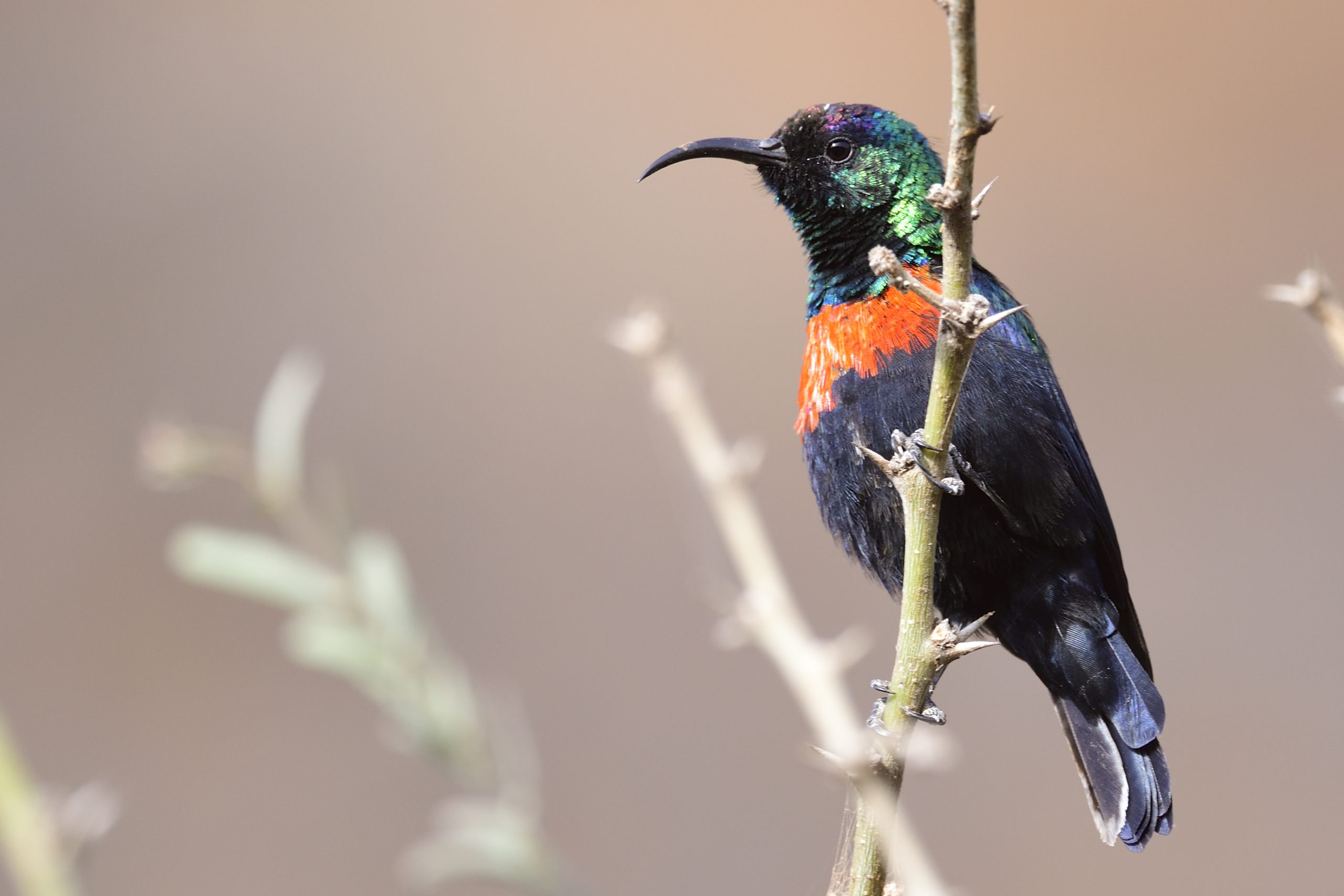
Selvine and I were ready for a Kenyan trip early February. The official trip was supposed to start on the morning of February 9, but we drove to Nairobi already on February 6. I was having 3 birders with me on the trip: Per Olav from Norway who would arrive late evening February 8, Trygve from Cape Town, South Africa who would arrive on February 7 and Jim, an Englishman living in coastal Kenya that was already there when we arrived at Hotel Troy in the early afternoon on February 6. Hotel Troy is located only about 1 km from the entrance gate to Nairobi National Park and was priced quite good. We paid less than USD 40 pr. night for a single room.
Day 1, Sunday, February 6 – Nairobi Safari Walk and The National Museum
Jim and I agreed the night before that we should visit Nairobi Safari Walk in the morning of the first day. The other 2 persons had not arrived yet. We drove to the entrance and picked up our guide Michael there. I had never been to this Safari Walk before so I did not know what to expect. We arrived around 08:00 at the gate and registered amongst others the following species on this short walk: Red-bellied Parrot, Spotted Palm Thrush, Hamerkop, White-headed Barbet, Red-chested Cuckoo, Holub´s Golden Weaver, Baglafecht Weaver, Northern Double-collared Sunbird, Abyssinian Thrush, Willow Warbler, Black-backed Puffback, Grey-backed Camaroptera, African Paradise Flycatcher, African Emerald Cuckoo, Lesser Honeyguide, Red-backed Mannikin, Black Cuckooshrike, White-bellied Tit, Chinspot Batis, Brown- backed Woodpecker (lifer, but no pictures), Yellow-rumped Tinkerbird, Crowned Eagle and Black-headed Oriole. We were out of the Safari Walk at around 12:30. We went back to the hotel for lunch. We left the hotel around 15:00 after lunch and was at the National Museum just before 16:00. Here are some of the species we recorded there: Red-billed Firefinch, White-eyed Slaty Flycatcher, Cinnamon-chested Bee-eater, Marabou Stork, Baglafecht Weaver, Abyssinian Thrush, Yellow-billed Kite, African Pied Wagtail, Northern Double-collared Sunbird, Bronzy Sunbird, Amethyst Sunbird, White-bellied Tit and Scarlet-chested Sunbird. We left the museum around 17:30, dropped Michael on the way and got terrible lost in a not so favourable neighbourhood. After a while I managed to navigate out of that area and we were back at the hotel around 18:30.
Some pictures from Day 1:

White-headed Barbet, Lybius leucocephalus –

African Paradise Flycatcher, Terpsiphone ciridis

White-eyed Slaty Flycatcher, Melaenornis fischeri – Endemic to E and C Africa

Bronzy Sunbird, Nectarina kilimensis

Abyssinian Thrush, Turdus abyssinicus – Endemic to East Africa

Baglafecht Weaver, Ploceus Baglafecht
Day 2, Monday, February 7 – Karura Forest and Nairobi Safari Walk.
Trygve arrived in the evening of the 6th. He had bought a brand new lens in Cape Town for me: AF-S NIKKOR 500mm f/5.6E PF ED VR. I actually saved more than $ 1.000 by buying it in South Africa instead of Norway. Trygve, Jim, Michael the guide and I left quite early that morning and we were at the gate of Karura Forest at around 08:30. It were a fairly long walk in that forest and we were rewarded with amongst other birds: Little Grebe, White-backed and Yellow-billed Duck, Common Moorhen, Rüppel´s Robin-Chat, Common Waxbill, Streaky Seed-eater, European Bee-eater, Placid Greenbul, Narina Trogon and White-bellied Tit. We went back to the hotel for an early lunch. Jim did not want to go with us in the afternoon, so Trygve, Michael and me went back to the Nairobi Safari Walk. Some of the birds we saw included: Yellow-breasted Apalis, Cardinal Woodpecker, Dusky Turtle Dove, Lesser Striped Swallow, Hartlaub´s Turaco, Yellow-billed Stork, Spot-flanked Barbet, Klaas´s Cuckoo, White-eyed Slaty Flycatcher, White-bellied Tit, Africn Dusky Flycatcher, Brown-crowned Tchagra and near the exit Mbulu White-eye (Lifer). I tried very hard to find the Brown-backed Woodpecker, but no success. We left the Safari Walk quite early and went back to the hotel.
Some pictures from Day 2:

Little Grebe, Tachybabtus ruficollis

Placid Greenbul, Phyllastrephus placidus – Endemic to SE Africa

White-bellied Tit, Melaniparus

Mbulu White-eye, Zosterops mbulensis – Endemic to N Tanzania and S Kenya

Me, Michael and Trygve at Nairobi Safari Walk
Day 3, Tuesday, February 8 – Nairobi National Park
We left early that morning and the plan was to spend all day inside the National Park. We were at the gate around 07:00 and started to registrating birds: Cape Robin-Chat, Crested Francolin, Three-banded Plover, Rufous-naped Lark, Grey-backed Fiscal, Diederik Cuckoo, Cuckoo-finch (EA Lifer for me), Grey Crowned Crane, Isabelline Wheatear, Pangani Longclaw, Winding Cisticola, African Fish Eagle, Long-toed Lapwing, Spur-winged Lapwing, Black Crake, Black-winged Stilt, African Palm Swift, Malachite Kingfisher, Schalow´s (Abyssinian) Wheatear, Northern Fiscal, Kenya Sparrow, Reichenow´s Seed-eater, Greater Kestrel, Foxy Lark, Dusky Turtle Dove and Red-rumped Swallow. All of these were registered before we stopped for breakfast. After breakfast, we continued deeper into the park. Northern Pied Babbler, Common Ostrich, Common Kestrel, Yellow-necked Spurfowl, Red-collared Widowbird, Zitting Cisticola, Rosy-throated Longclaw, Golden-breasted Bunting, Red-billed Oxpecker, Long-tailed Fiscal, Yellow-throated Longclaw, Common Waxbill, Red-chested Cuckoo, White-backed Vulture, Rüppel´s Starling, European Roller, African Openbill, Secretarybird and Foxy lark were some of the birds we saw between Breakfast and lunch. We stopped at a picnic site for lunch. After a short stop, we were on the road again. We had now turned and were driving back towards the entrance of the park. We took some other routes than on the way in and added amongst others, the following species: Marabou Stork, Green Sandpiper and African Darter. We were out of the park around 16:30. We drove back to the hotel. The safari and the official 2 week trip were supposed to start the day after.
Some pictures from Day 3:

Cuckoo-finch (male), Anomalospiza imberbis

Cuckoo-finch (female), Anomalospiza imberbis

Long-toed Lapwing, Vanellus crassirostris

Rufous-naped Lark, Mirafra africana

Schalow´s (Abyssinian) Wheatear, Oenanthe Schalowi – Endemic to E Africa

Red-rumped Swallow, Cecropis daurica
Day 4, Wednesday, February 9 – Nairobia via Sagana to Castle Forest Lodge
We took off from Hotel Troy in the morning. The traffic through Nairobi were not too bad and we were soon on the highway going North. We overshot our first stop and overshot our guide Francis. We ended up in Sagana. We turned around and met Francis at the turn off to the Sagana Getaway resort. This is a place we have only dipped on the Endemic Hinde´s Babbler once. On the first stop, no luck, but on the way to the lodge we got amongst other these species: D´Arnaud´s Barbet, Southern Black Flycatcher and Red-headed Weaver. At the parking lot of the lodge we finally found and photographed the Hinde´s Babbler together with an Orange-breasted Bushshrike and a Greater Honeyguide. With our endemic target bird in box, we turned and continued towards Castle Forest. Selvine had gone in front with her rental car and she was already there. We had lunch at the restaurant We decided to bird the garden of the lodge in the first afternoon. These are some of the birds we recorded: Hunter´s Cisticola, Red-winged Starling, Cinnamon-chested Bee-eater, Red-backed Mannikin, Crowned Eagle, White-eyed Slaty Flycatcher, Black Saw-wing, Grey-headed Nigrita, Brown-capped Weaver, Kikuyu White-eye, Tacazze Sunbird, Streaky and Thick-billed Bee-eater, African Emerald Cuckoo, Moustached Tinkerbird, Abyssinian Thrush, Tropical Boubou, Isabelline Wheatear, Spectackled Weaver, African Dusky Flycatcher, Brown Woodland Warbler, African Paradise Flycatcher, Chesnut-throated Apalis, African Hill babbler, Evergreen Forest Warbler, Grey Apalis and Northern Double-collared Sunbird. We had to return a little early to camp since there were a conference in the area when we first arrived where we were going to pitch the tents. We hurried to set up camp, freshened up and met at the lodge for dinner. After dinner we sat a little by the bonfire in camp before we one by one retired to sleep.
Some pictures from Day 4:

Hinde´s Babbler. Turdoides hindei – Endemic to Kenya

Hunter´s Cisticola, Cisticola hunteri – Endemic to E Africa

Grey Apalis, Apalis cinereea
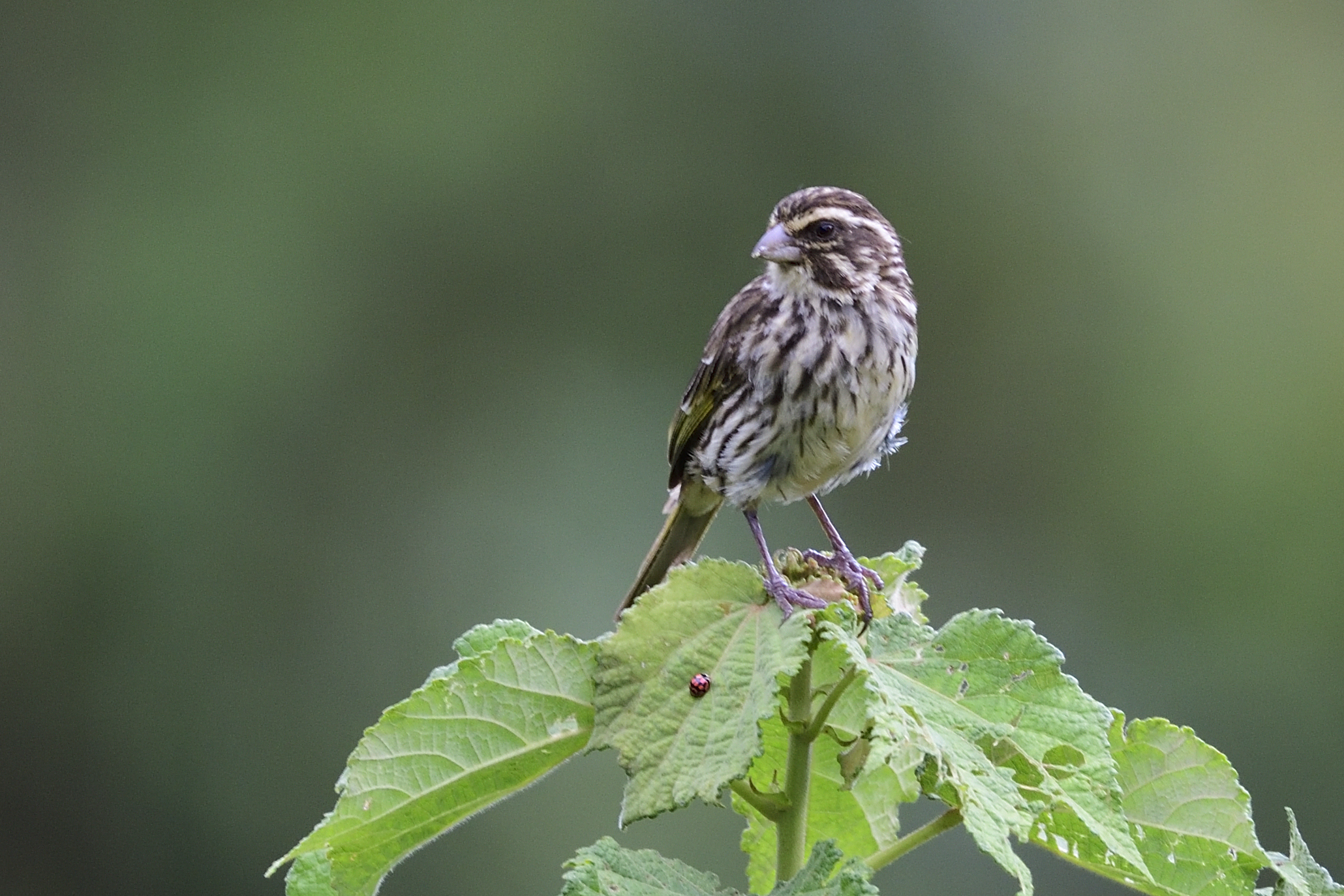
Streaky Seed-eater, Chritagra striolita
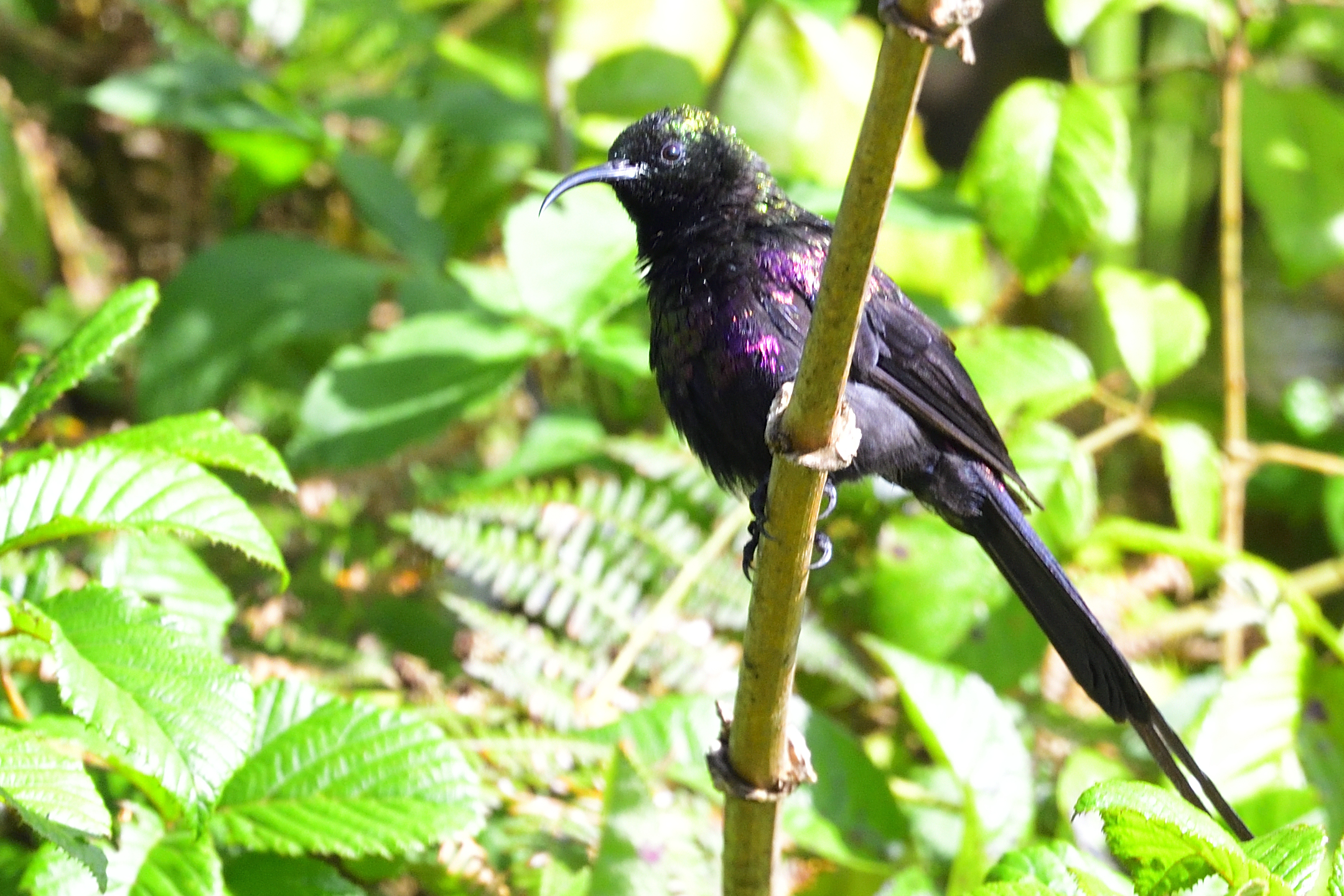
Tacazze Sunbird, Nectarina tacazze – Endemic to NE Africa

Baglafecht Weaver, Ploceus baglafecht
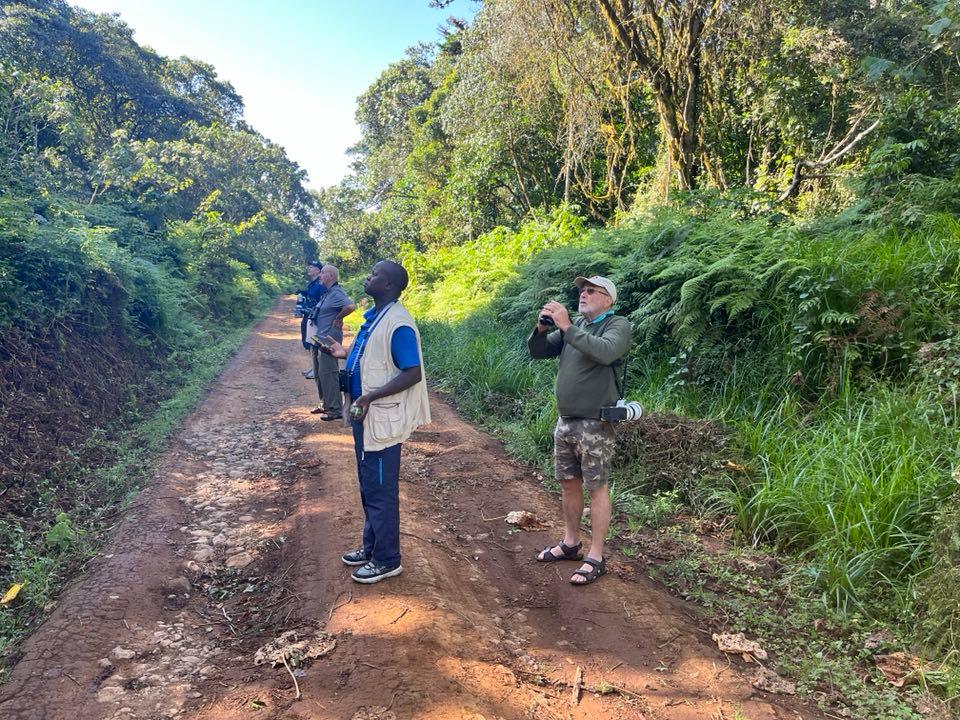
Birding in Castle Forest
Day 5, Thursday, February 10 – Castle Forest Lodge.
The first bird obserbed this morning was a Red-fronted Parrot in the garden of the lodge. We could also hear a Barred Long-tailed Cuckoo and a Hartlaub´s Turaco calling. We got into Lizzie and started to bird down towards the gate. We drive the car and stop then walk until I cannot see the car, then I go back and pick up the car and leapfrog them. We did that all the way down to the gate (morning and afternoon) and picked up the following new species for Castle Forest Lodge: Yellow-whiskered Greenbul, Cinnamon Bracken Warbler and Mountain Oriole. It was a quiet morning with not too much activity. We returned to the lodge for breakfast. After breakfast we drove down to were we stopped before breakfast and continued our list: Bare-tailed Trogon, Olive-breasted Greenbul, Fine-banded (Tullberg´s) Woodpecker, White-bellied Tit, Waller´s and Kenrick´s Starling, Long-crested Eagle, Black-fronted Bushshrike, Olive Sunbird, Purple-throated Cuckooshrike and Grey-backed Camaroptera. We returned to the Lodge for lunch and again drove down to finish the run: Mountain Buzzard, Yellow-crowned Canary, Silvery-cheeked Hornbill, Scaly Francolin, Giant Kingfisher, Mountain Wagtail, Crowned Hornbill, Grey Cuckooshrike and Baglafect Weaver.
We freshened up and had dinner. Some time were spent by the bonfire before we retired to bed.
Some pictures from Day 5:

Red-fronted Parrot, Poicephalus gulielmi

Mountain Oriole, Oriolus percivali – Endemic to E Africa

Black-fronted Bushshrike, Chlorophoneus nigrifrons

Black-throated Apalis, Apalis jacksoni

Cinnamon-chested Bee-eater, Merops oreobates – Endemic to E Africa

Purple-throated Cuckooshrike, Campephaga quiscalina

Grey-headed Nigrita, Nigrita canicapillus

Thick-billed Seed-eater, Chritagra burtoni
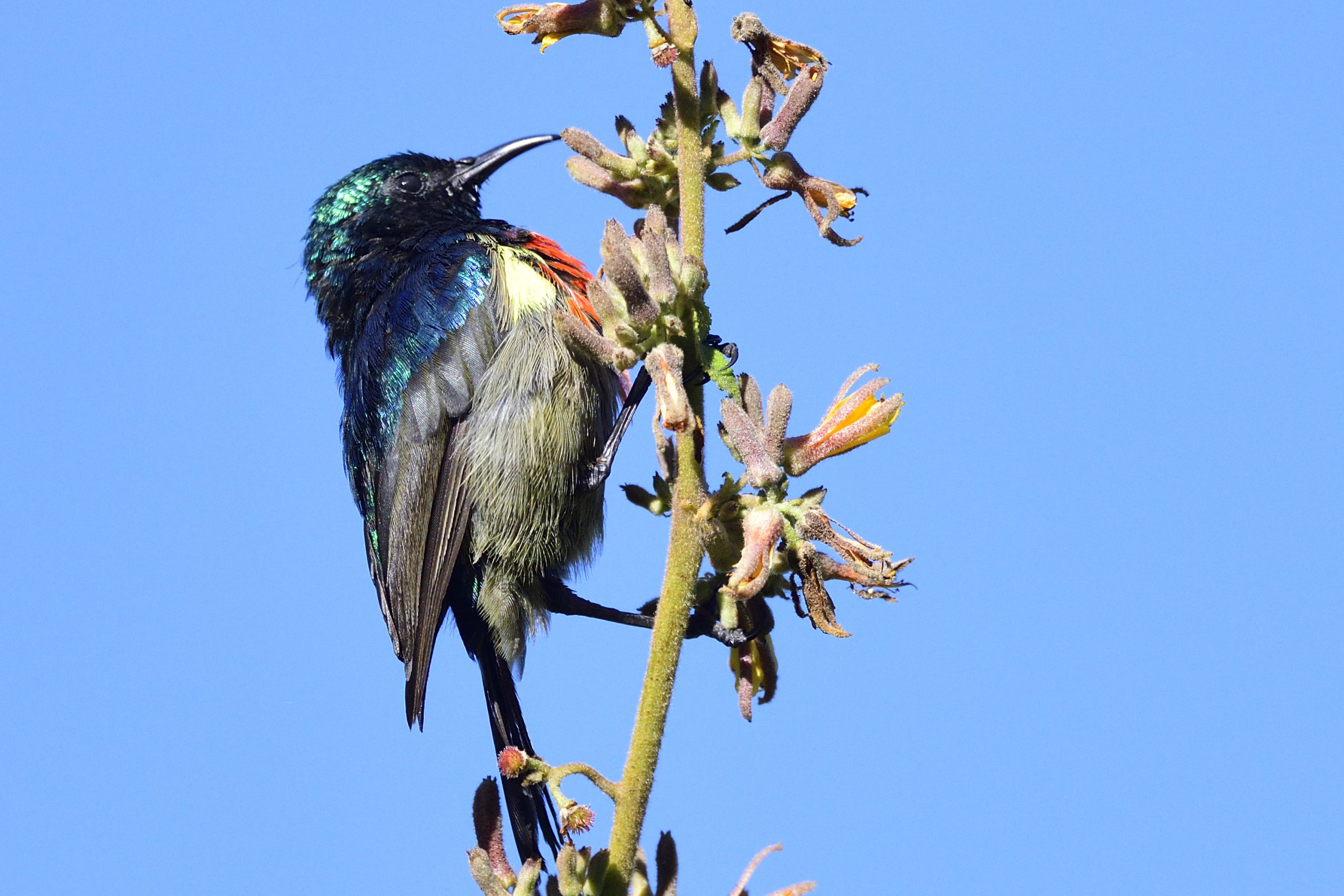
Northern Double-collared Sunbird, Cinnyris reichenowi

Moustached Tinkerbird, Pogoniulus leucomystax

Hartlaub´s Turaco, Tauraco hartlaubi – Endemic to E Africa

Brown Woodland Warbler, Phylloscopus umbrovirens – Endemic to NE Africa
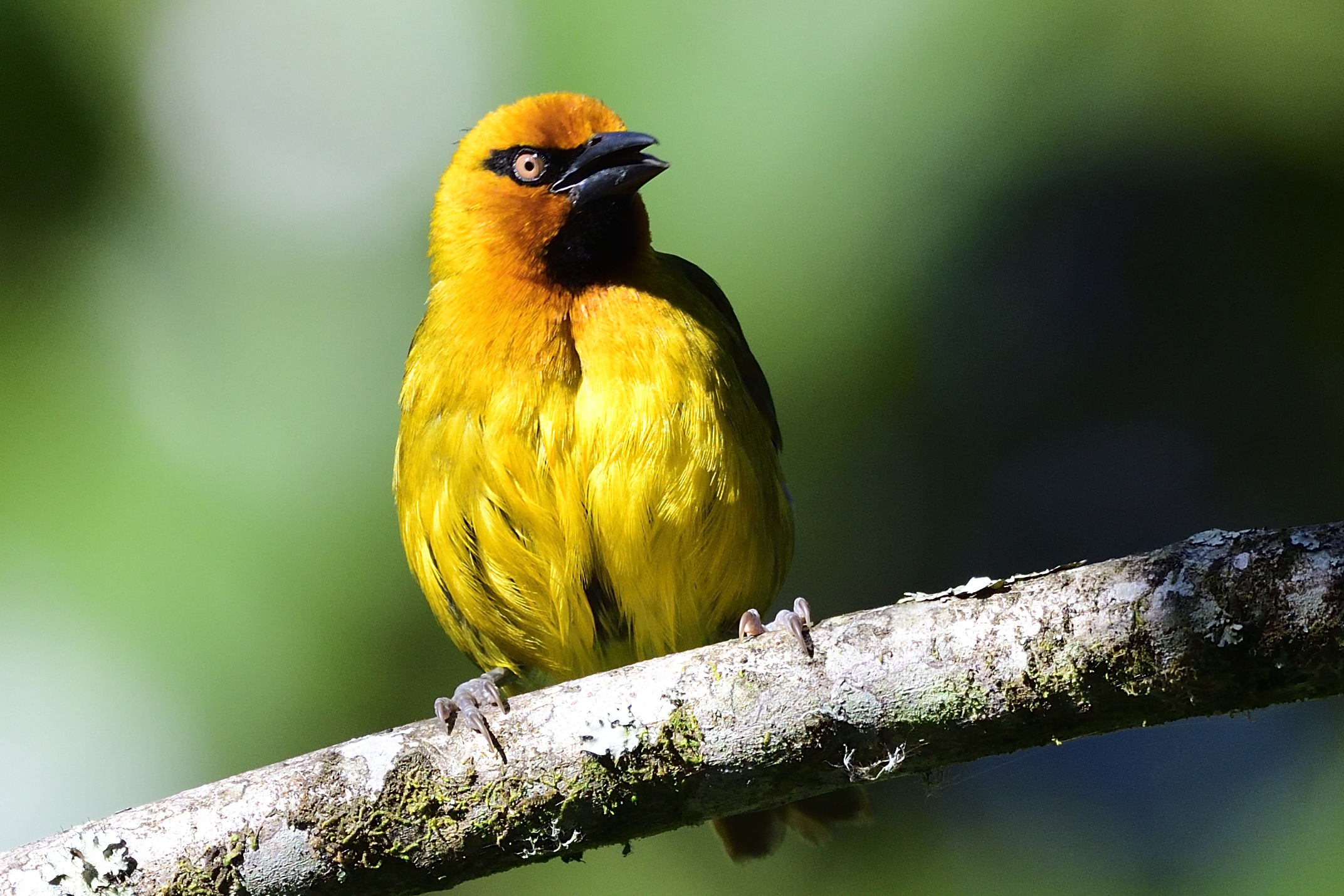
Spectackled Weaver, Ploceus ocularis

Kikuyu White-eye, Zosterops kikuyuensis – Endemic to Kenya
Day 6, Friday, February 11 – Castle Lodge.
We birded the same area as the days before and added only one of our targets, White-headed Hoopoe to our list. However, we got a chance to get or improve on the pictures from the previous days.
Some pictures from Day 6:

Grey Apalis, Apalis cinerea

Northern Double-collared Sunbird, Cinnyris reichenowi
Day 7, Saturday, February 12 – Castle Forest Lodge to Samburu.
We birded the garden of the lodge in the morning an added Blue-headed Coucal and African Olive Pigeon. I left the boys early in order to pack camp. After breakfast, we loaded the car and headed for Archer´s Point and Samburu National Reserve. Per Olav drove with Selvine. We were at the park gate around 14:00. In Samburu I normally camp at the river separating Samburu from Buffalo Springs, but the bridge was washed out sometime in 2020 and is not yet fixed. I gave Selvine the mission to find us a place to sleep that night. We entered the park and started ticking birds: Black-faced Sandgrouse, White-headed Buffalo Weaver, Somali Ostrich, Tawny Eagle, Parrot-billed Sparrow, Northern Red-billed Hornbill, Taita Fiscal, Yellow-spotted Bush Sparrow, Superb Starling, Donaldson Smith´s Sparrow-Weaver, African Grey Flycatcher, Red-tailed Shrike, D´Arnaud´s Barbet, Rufous-tailed Scrub Robin, White-throated Bee-eater, Namaqua Dove, Black-capped Social Weaver, White-backed Vulture, Abyssinian Scimitarbill and Vulturine Guineafowl. We had now reached the river and it was already 16:00. We birded a little around my normal campground and added Grey-headed Kingfisher, Blue-naped Mousebird and Lesser Honeguide before we climbed in to the car and started our way back to the gate. Some of the birds we observed on the way out included: Crested Francolin, Von der Decken´s Hornbill, Brubru, White-bellied Go-away-bird, Red-billed Oxpecker, Eastern chanting Goshawk, Eastern Violet-backed Sunbird, Common Kestrel, Red-beellied Parrot, Pygmy Falcon and Northern White-crowned Shrike. We dipped on quite a few birds that day: Brown-tailed Apalis, Acacia Tit, Somali Bee-eater, Fischer´s and Golden-breasted Starling. We went to the hotel that Selvine had found for us. Had dinner and retired early to bed.
Some pictures from day 7:
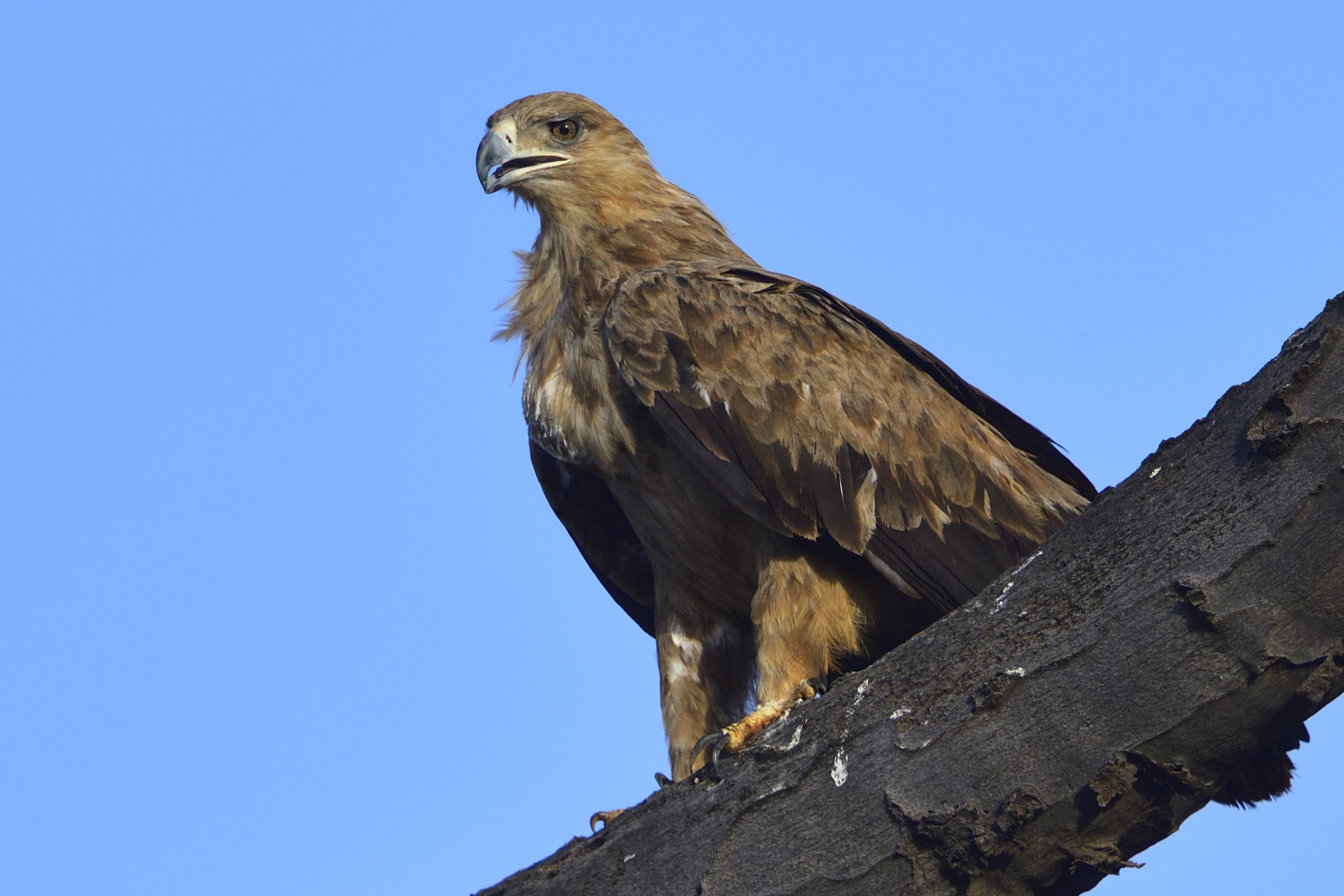
Tawny Eagle, Aquila rapax
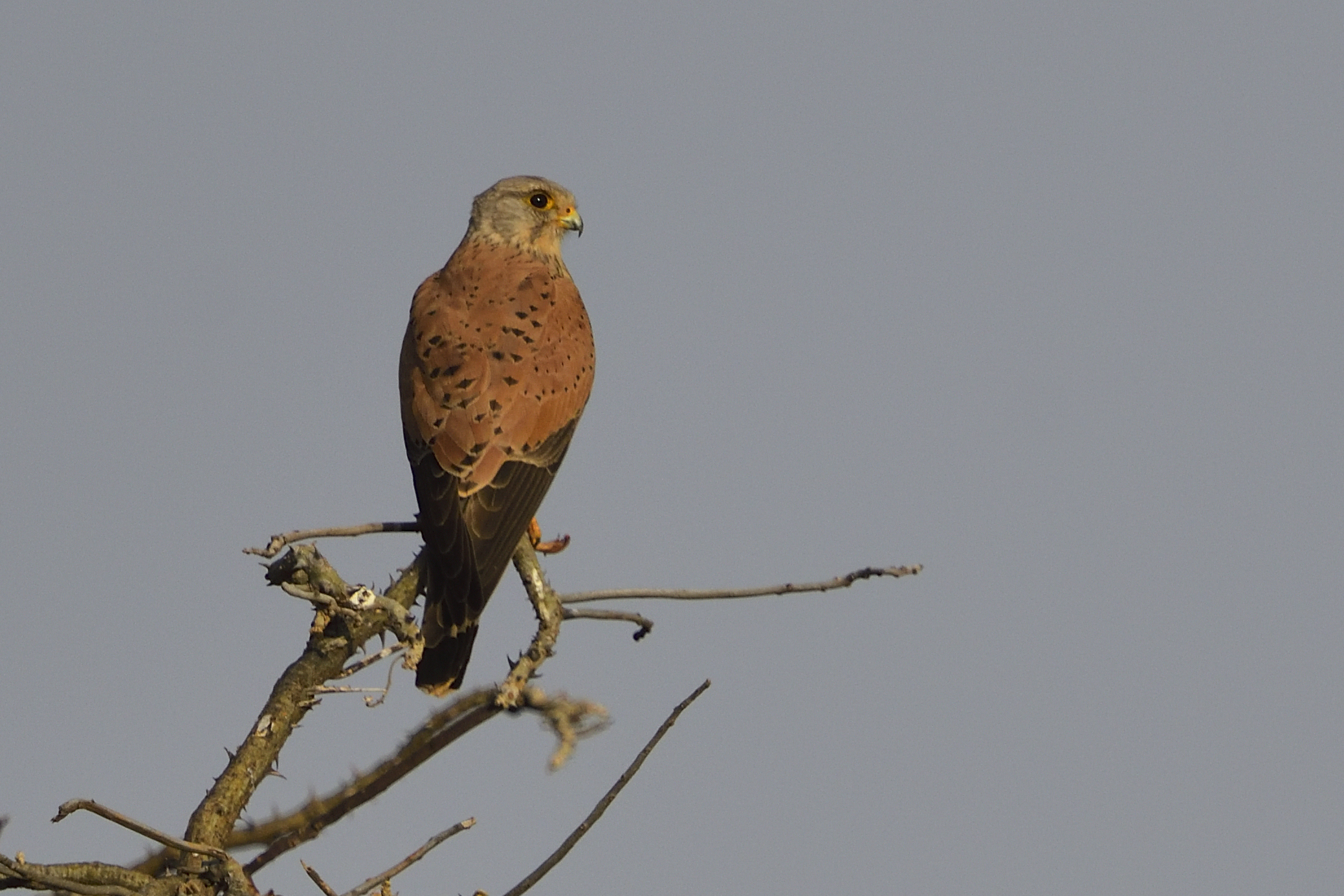
Common Kestrel, Falco tinnuncilus
Day 8, Sunday, February 13 – Samburu – Buffalo Springs – Naru Moro.
We drove down to the entrance of Buffalo Springs and started birding from the car. We were very lucky and had multible sightings of Somali Courser just inside the park: Other new birds for Samburu/Buffalo Springs encountered included: Hunter´s Sunbird and Brown Snake Eagle. We had now reached the spring that the park is named after, We did some birding while having breakfast and found and photographed:Black Crake, Black-throated Barbet, White-browed Sparrow-Weaver and Vulturine Guineafowl. After breakfast we continued towards the bridge. Here are some of the birds we added to our list: Chestnut Weaver, Grey Wren-Warbler, Red-billed Quelea, Black-necked Weaver, Dodson´s Bulbul, Slate-coloured Boubou, Pink-breasted Lark, Martial Eagle, Rufous Chatterer, White-headed Mousebird, Fan-tailed Raven, Nubian Woodpecker, Spotted Palm Thrush, Red-fronted Barbet, Red-fronted Prinia, Chestnut bellied Sandgrouse and Buff-crested Bustard. We had now reached the bridge. There were very little water in the river, just a tiny trickle. Around the trickle, we found Hooded Vulture, Tawny Eagle and Marsh Sandpiper. We went back in the car and added only Cut-throat Finch and Bateleur to our bird list on our way to the gate. However, we did see a Cheetah with her cubs. We exited the park and stopped just after Isiola for a special place we have for Boran Cisticola. It did not take us long to find the Cisticola. We returned to the car and continued towards Naru Moro. We had lunch and Trygve and Per Olav opted to stay in a room each. This turned out to be very good since Selvine were nowhere to be found. She had all the tents and camping gear in her car. She was not reachable on her phone and all kind of thoughts went through my brain what might have happened. Either her rental car had broken down or something much worse had happened. I could not sleep that night. Jim preferred to sleep in a chair, so he slept in the front seat of Lizzie and I tried to sleep in my rooftop tent to no avail.
Some picture from day 8:

Somali Course, Cursorius somalensis – Endemic to NE Africa
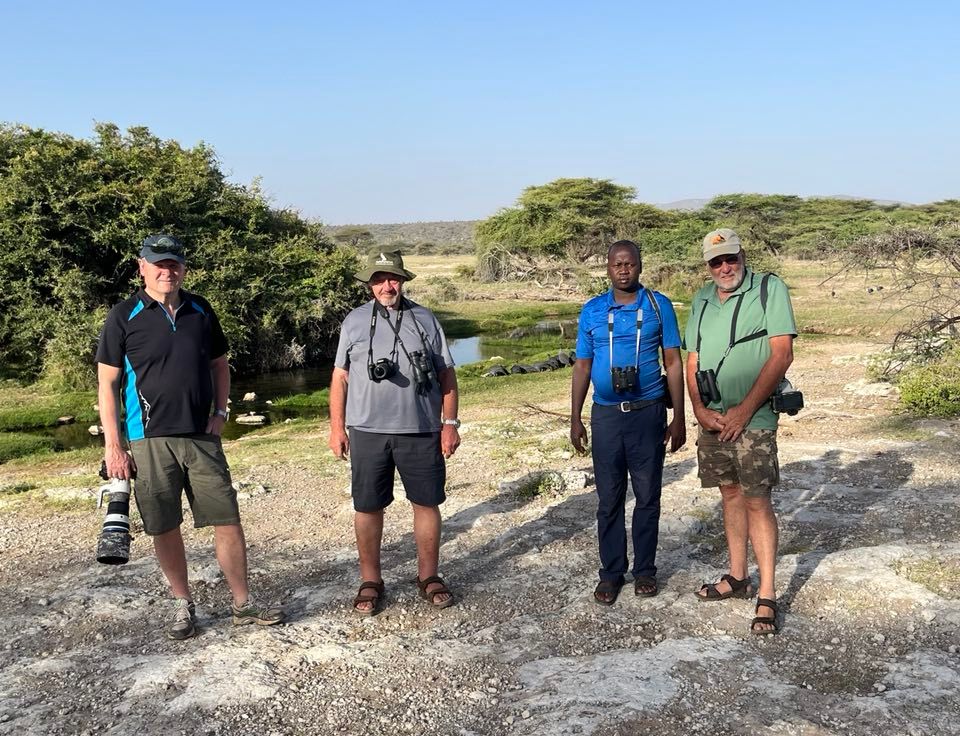
Per-Olav, Jim, Francis and Trygve at Bufflao Springs

Black Crake, Amaurornis flavirostra
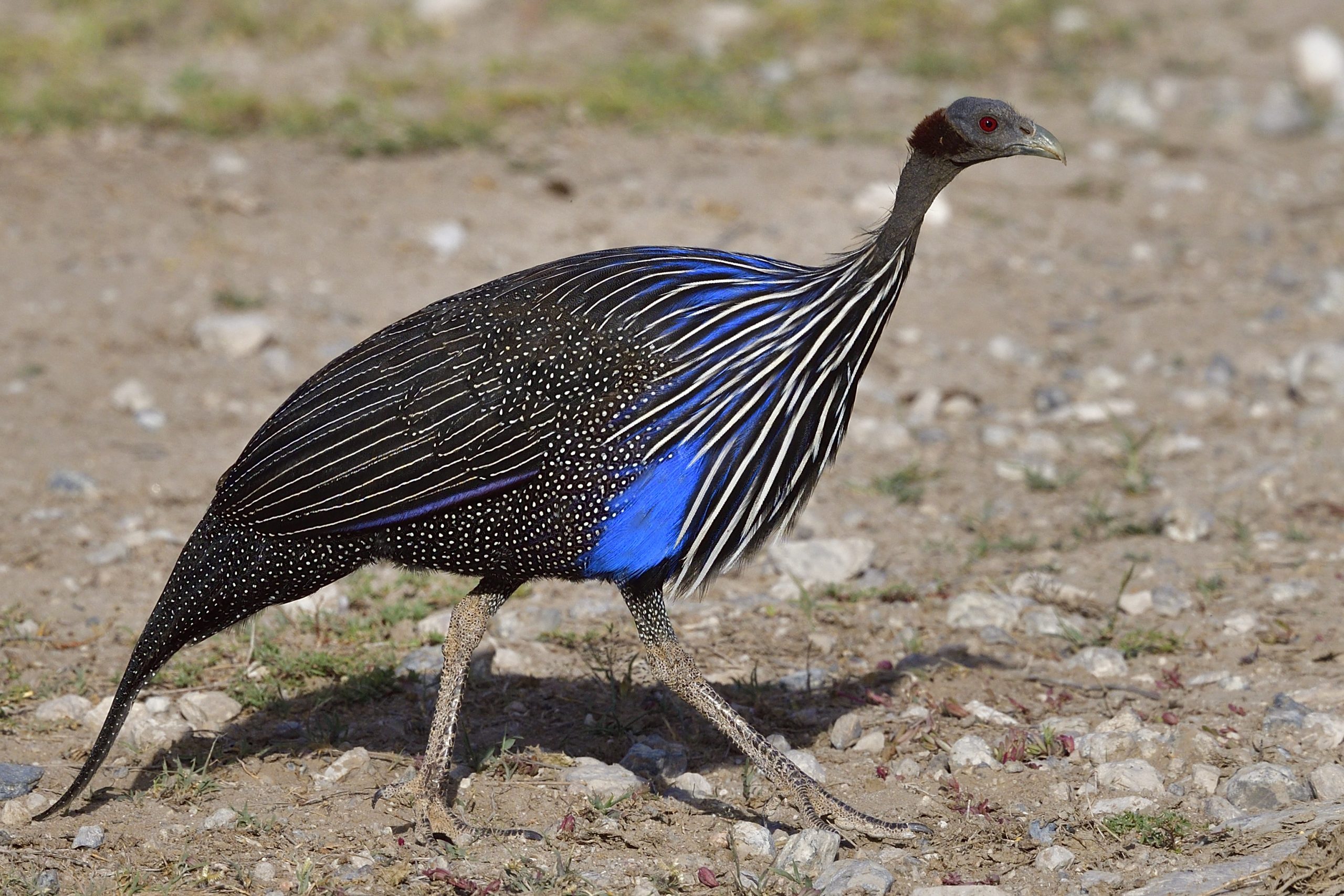
Vulturine Guineafowl, Acryllium vulturinum

Black-throated Barbet, Thricolaema melanocephala – Endemic to NE Africa

White-browed Sparrow-Weaver, Plocepasser mahali

Donaldson Smith´s Sparrow-Weaver, Plocepasser donaldsoni – Endemic to NE Africa

White-billed Buffalo-Weaver, Bubalornis albirostris – Endemic to NE Africa

Hooded Vulture, Necrosyrtes monachus

Cheetah

Boran Cisticola, Cisticola bodessa -Endemic to NE Africa.
Day 9, Monday February 14 – Naru Moro – Lake Baringo
When Jim and I came down to the lobby that morning, Selvine had just arrived. Her rental car had broken down. She had not had any reception all night, but I was very happy to see her. She had arrived with a driver. We could not all fit in Lizzy and since I had not slept all night, I was not in a position to drive Lizzie. I asked Trygve if he could drive. So Trygve, Jim, Per-Olav and Francis took the Landy while Selvine and I drove with her driver to Lake Baringo. Being sleep deprived, I fell asleep right away. We reached Lake Baringo and I managed to negotiate reasonable prices for the rooms at Sandai Resort, so no more camping. On this trip, we normally camp many places, but as it turned out, we only camped 3 nights in Castle Forest for the entire trip. The others had stopped according to plan for the Mackinder race of the Cape Eagle-Owl, Fischer´s Lovebird and White-billed Buffalo Weaver. They had also found the Black-headed Lapwing, one of our targets. There was no time to do any birding that afternoon, so we had dinner and retired to bed.
Day 10, Tuesday, February 15 – Lake Baringo.
We started the day birding at the cliff face. We had beautiful light in the morning. Here are some of the birds we saw: Green-winged Pytilia, Beautiful and Eastern Violet-backed Sunbird, Lanner Falcon, White-bellied Go-away-bird, Bristle-crowned Starling, Brown-tailed Rock Chat, Jackson´s Hornbill, Mocking Cliff Chat, Black-faced Waxbill, Northern Crombec, Yellow-spotted Bush Sparrow (Petronia), Little Weaver, White-bellied Canary, Shining Sunbird (Lifer for me!), Brown-tailed Apalis, and Blue-cheeked Bee-eater. We tried for the Pale Prinia, but no luck. It was now past 11:00 and real hot. We returned to the resort. Selvine and I relaxed in the pool until lunch. At that point Francis takes his motorcycle and go and look for the roosting spot for some of the nocturnal species. He is coming back in the afternoon to take us there. My friends were a little bored so I took them down to the lake were there used to be a spot for the Brown Babbler. I could not find it and neither did Francis for us, so we dipped on that species. I did find an African Grey Woodpecker though. We went back to the resort and around 17:00 Francis showed up. The first stop was for the Slender-tailed Nightjar. On the way to the Greyish Eagle Owl we saw Magpie Starlings. Then we went to a new spot to find the Northern White-faced Owl. Other birds that Afternoon: Yellow-billed Eremomela, Spotted Thick-knee and White-eared Barbet. We were back at the resort quite late and only had time for a shower before dinner.
Some pictures from Day 11

Shining Sunbird, Cinnyris habessinicus – Endemic to NE Africa – Lifer

African Grey Woodpecker, Dendrpicos goerta

Greyish Eagle-Owl, Bubo cinereascens

Northern White-faced Owl, Ptilopsis leucotis
Day 11, Wednesday, February 16 – Lake Baringo.
That morning we were going to have a boat ride on the lake. We had a few target species namely Northern Masked Weaver and Northern Red Bishop. We found the first one, but the Bishop were nowhere to be seen. It was the first time i dipped on this species at Lake Baringo. Here are some of the other birds we saw/photographed: Black-crowned Night-Heron, Malachite Sunbird, Purple Heron, Wattled Starling, Goliath Heron, Squacco Heron, Reed Cormorant, African Darter, Northern Crombec, Glossy Ibis, Striated Heron, African Jacana, Little Egret, Golden-backed Weaver, African Spoonbill, White-breasted Cormorant, Red-billed Quelea, Northern Carmine Bee-eater, White-winged Black Tit, African Snipe, Common Ringed Plover, Black Heron, Common Greenshank, Kittlitz´s Plover, African Swamphen, Black Crake, Wood Sandpiper, Black-winged Stilt, Western Osprey, White-faced Whistling Duck, White-throated Bee-eater, Blue-cheeked Bee-eater, White-winged Tern, Egyptian Geese, Rüppel´s Starling and Grey-headed Silverbill. We were back around 10 and went back to the resort to relax. Francis were supposed to come back to pick us up around 15:00. Some of us relaxed by the pool whilst others were sleeping or downloading pictures. We had lunch and Francis returned at 15:00. In the mean time he had found a Three-banded Courser nest. That was our first stop. Our next target was Hemprich Hornbill. Francis had seen them earlier that day while scouting and took us right to them. Unfortunately they were perched on a wire, so i did not bother with a picture since I already have good pictures of them. At the Hemprich spot in the middle of a village. We also added Rufous Chatterer, Beautiful Sunbird and Northern Red-billed Hornbill at that site. We drove up to the plateau above the cliff face and parked at a little waterhole we had been to on previous trips. The boys racked up amongst others: Blue-capped Cordonbleu, Speckle-fronted Weaver, Slate-coloured Boubou, Red-cheeked Cordonbleu and White-bellied Canary. On the way back to the resort we observed several Common Ostrich. We stopped again for the Pale Prinia, but we could not entice it to show itself. We return to camp freshened up, Dinner a few drinks and bed.
Some pictures from Day 11

Goliath Heron, Ardea goliath

Purple Heron, Ardea purpurea

Malachite Kingfisher, Alcedo cristata

African Snipe, Gallinago nigripennis
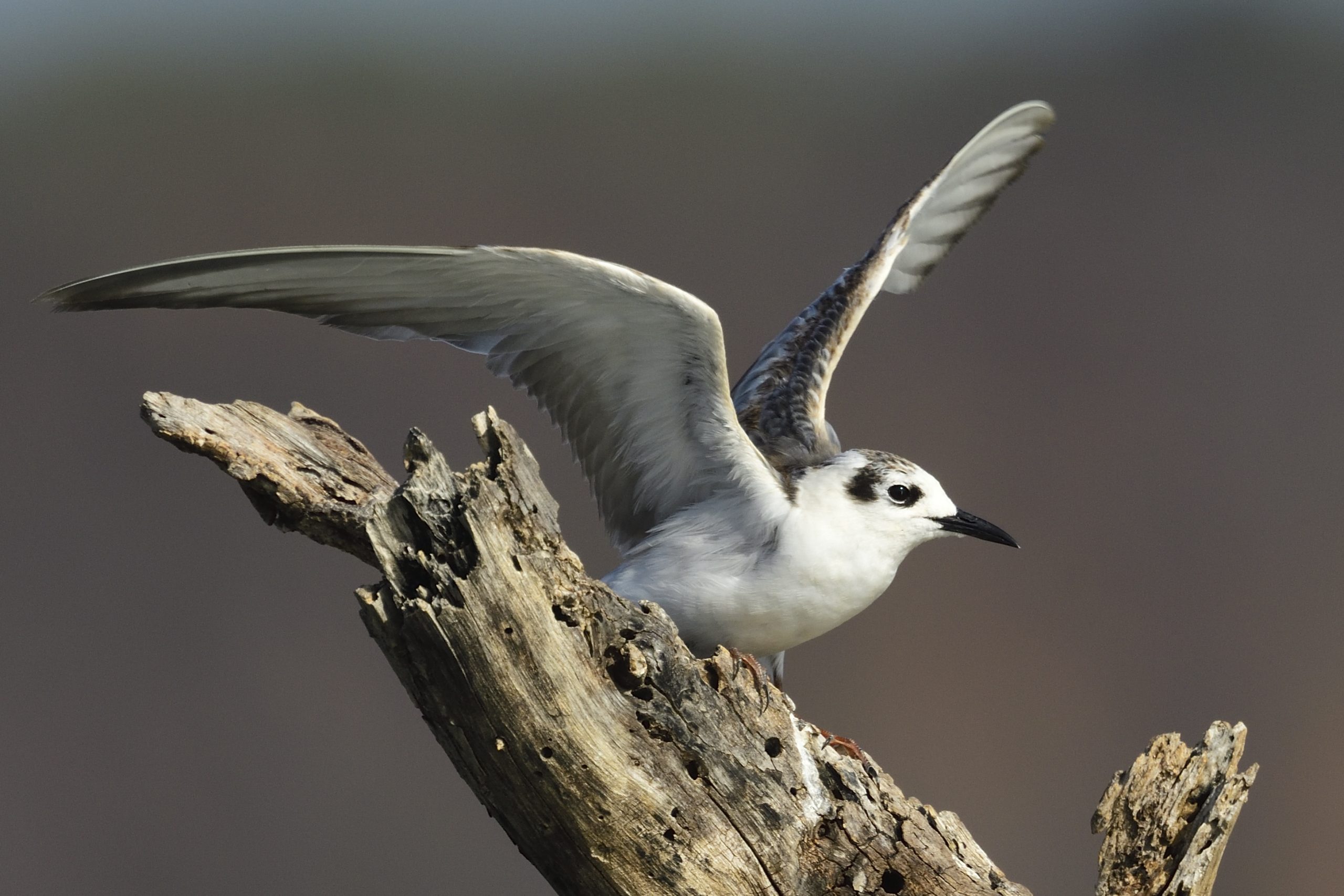
White-winged Tern, Chlidonias leucopterus
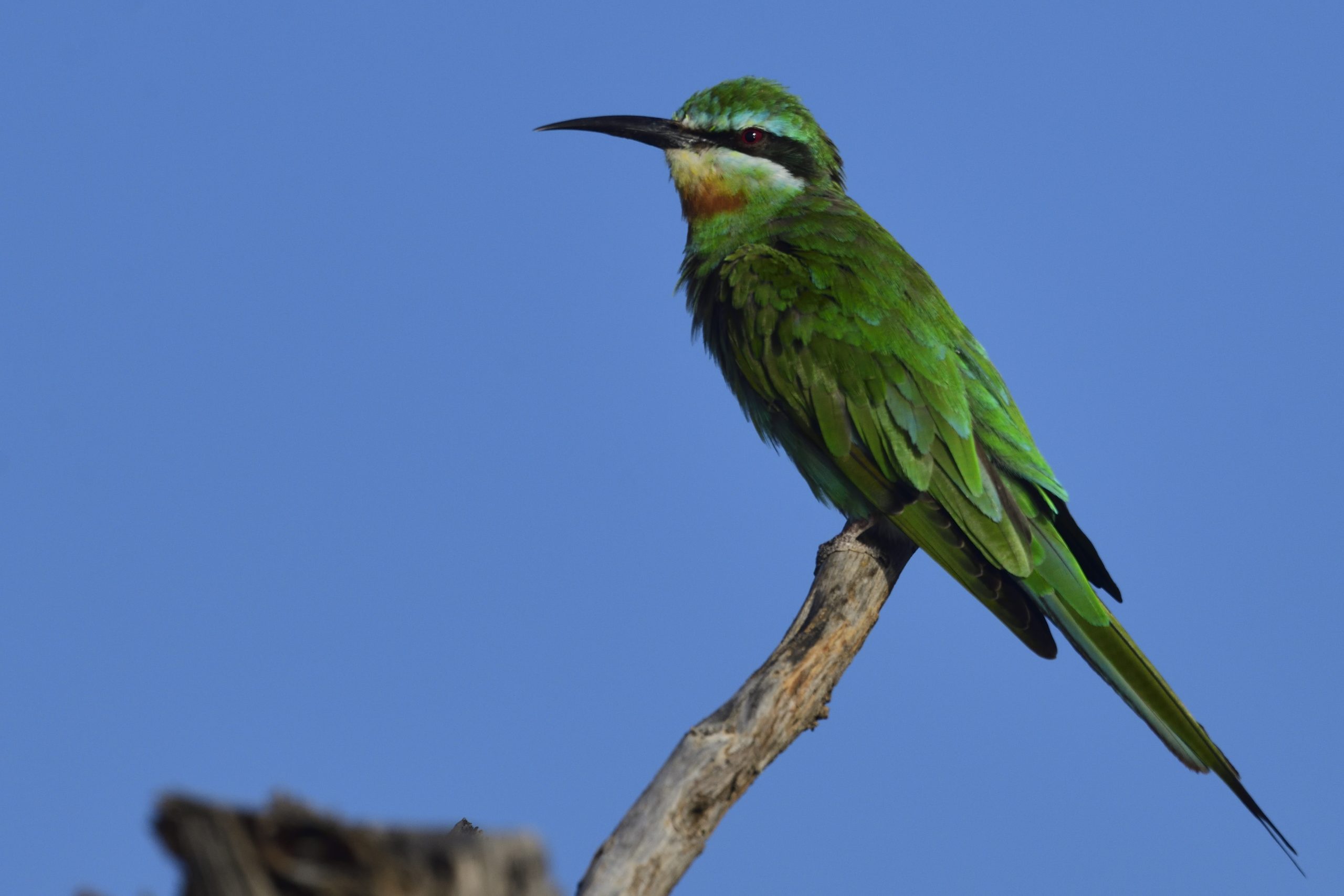
Blue-cheekd Bee-eater, Merops percicus

Northern Carmine Bee-eater, Merops nubicus

Rüppel´s Starling, Lamprotornis purpuropterus – Endemic to NE Africa

Three-banded Courser (male), Rhinoptilus cinctus
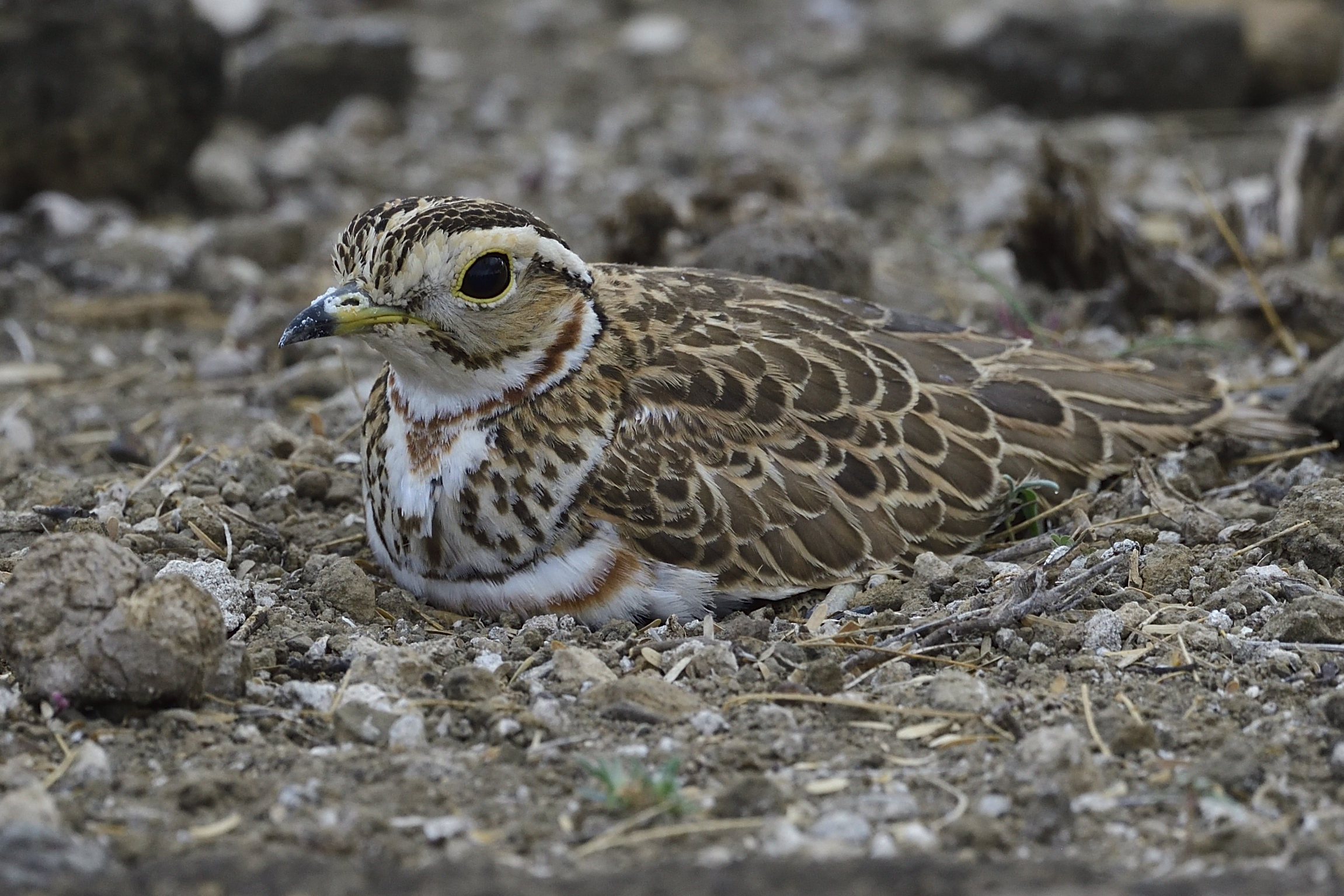
Three-bamded Courser (female), Rhinoptilus cinctus

Rufous Chatterer, Turdoides rubiginosa – Endemic to NE Africa

Beautiful Sunbird, Cinnyris pulchella

Shining Sunbird (female), Cinnyris habessinicus – Endemic to NE Africa – Lifer
Day 12, Thursday , February 17 – Lake Baringo – Kakamega Forest
That morning we tried to round up some of our missing species. Some of the birds we saw that morning at different locations around Lake Baringo: Dark Chanting Goshawk, Fan-tailed Raven, Slate-coloured Boubou, Purple Grenadier, Buff-bellied Warbler, Northern Brownbul, Shikra (EA Photo lifer for me) and Pearl-spotted Owlet. We went back to the resort and packed the car. We stopped in Marigat to fill Diesel and also to get better pictures of the White-billed Buffalo-Weavers that have a nesting colony next to the petrol station. We soon loaded up and was on our way to one of my favourite birding destination in East Africa: Kakamega Forest. This forest is where many typical DRC birds have their Eastern most distribution range. We arrived in Smith´s camp around 16:00 in the afternoon after a long drive, After checking in to Smith´s camp, I sat down with a beer in my hand and the camera in my lap. I noticed a Yellow-throated Leaflove in a tree in the garden and managed to get some pictures. Our guide Winstone arrived shortly afterwards and we took a short walk. Other interesting birds we got on the walk included White-headed Saw-wing, Red-tailed Bristlebill, Bronzy Sunbird and Petit´s Cuckooshrike.
We returned to camp where next door there was a burial in progress that kept us awake almost all night. We had dinner and retired to bed.
Some pictures from Day 12:

Shikra, Accipiter badius

Yellow-spotted Bush Sparrow (Petronia), Gymnoris pyrgita

Magpie Starling, Speculipastor bicolor – Endemic to NE Africa
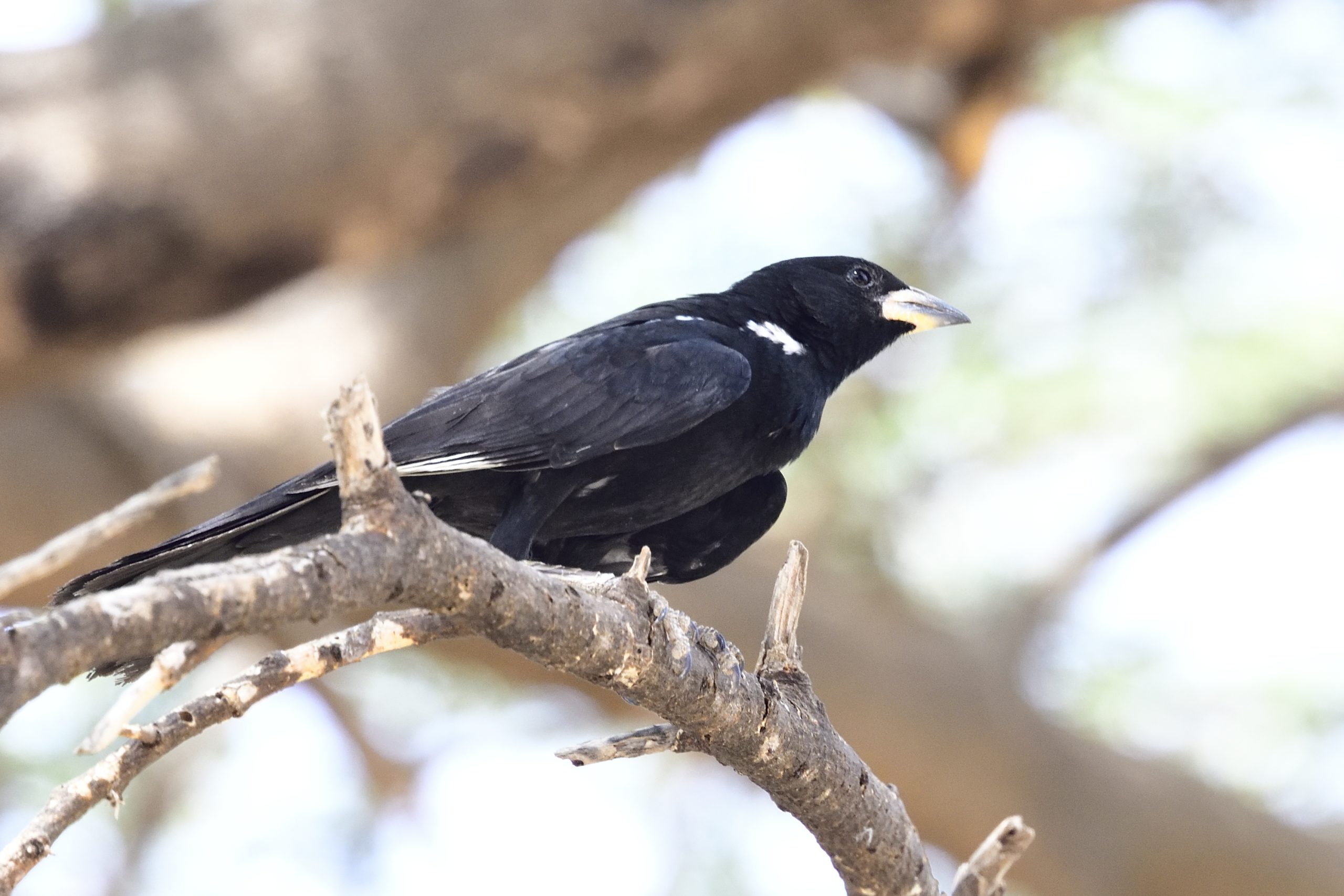
White-billed Buffalo Weaver, Dinemellia dinemelli

Yellow-throated Leaflove – Atimastillas flavicollis

Red-tailed Bristlebul, Bleda syndactylus
Day 13, Friday, February 18 – Kakamega Forest
A full day in Kakamega Forest. We were up early and were at the western edge of the forest by a bridge around 07:15. There is a small trail of less than 1 km up there that have produced some fantastic birds for me in the past. That day was not an exception. Here are some of the birds we registered the first morning in Kakamega Forest: Joyful Greenbul, Scaly-breasted Illadopsis, Stuhlmann´s Starling, African Blue Flycatcher, African Shrike-flycatcher, White-chinned Prinia, Sharpe´s Drongo, African Thrush, Black-billed Weaver, Brown-throated Wattle-eye, Black-faced Prinia, White-headed Wood Hoopoe, Lühder´s Bushshrike, Uganda Woodland Warbler, Grey-chinned Sunbird, Tambourine Dove, Northern Yellow White-eye, White-breasted Nigrita, Plain Greenbul, Ansorge´s Greenbul, Yellow-rumped Tinkerbird, Cabanis´s Greenbul, Black-faced Rufous Warbler, Yellow-billed Barbet, Red-headed Bluebill, Snowy-crowned Robin-Chat, Yellow-whiskered Greenbul, Yellow-spotted Barbet, Black Sparrowhawk, Turner´s Eremomela, Pink-footed Puffback, Cinnamon-chested Bee-eater, Buff-throated Apalis and Black-and-white-casqued Hornbill. It was now 10:00 so we returned to camp for breakfast. We went to the Rondo retreat after breakfast and birded the garden there + one of the many trails behind the retreat. Some of the birds we added included: Little Greenbul, Mackinnon´s Shrike, Crowned Eagle, Green-headed Sunbird, White-spotted Flufftail. Vieillot´s Black Weaver, Bocage´s Bushahrike, Black Saw-wing, Thick-billed Seed-eater, White-eyed Slaty Flycatcher. It was now 14:00 and time for lunch. In the afternoon we went to a grassland (Ikalunya) I had never been to before. We were told it was a jang out for Yellow-mantled Widowbird. We found Stout Cisticola and Black-necked Weaver there. It looked like it was going to rain, but I pushed on a little to scout the area. My only reward was a Purple Roller. On the way back to camp we managed to get Toro Olive Greenbul, a White morphed African Paradise Flycatcher and just before we got to camp one of the main targets: Blue-headed Bee-eater. It was 18:30 before we reached camp and we had time to freshen up before dinner. A very productive day indeed.
Some pictures from Day 13:

Pink-footed Puffback, Dryoscopus angolensis

Cinnamon-breasted Bee-eater, Merops oreobates
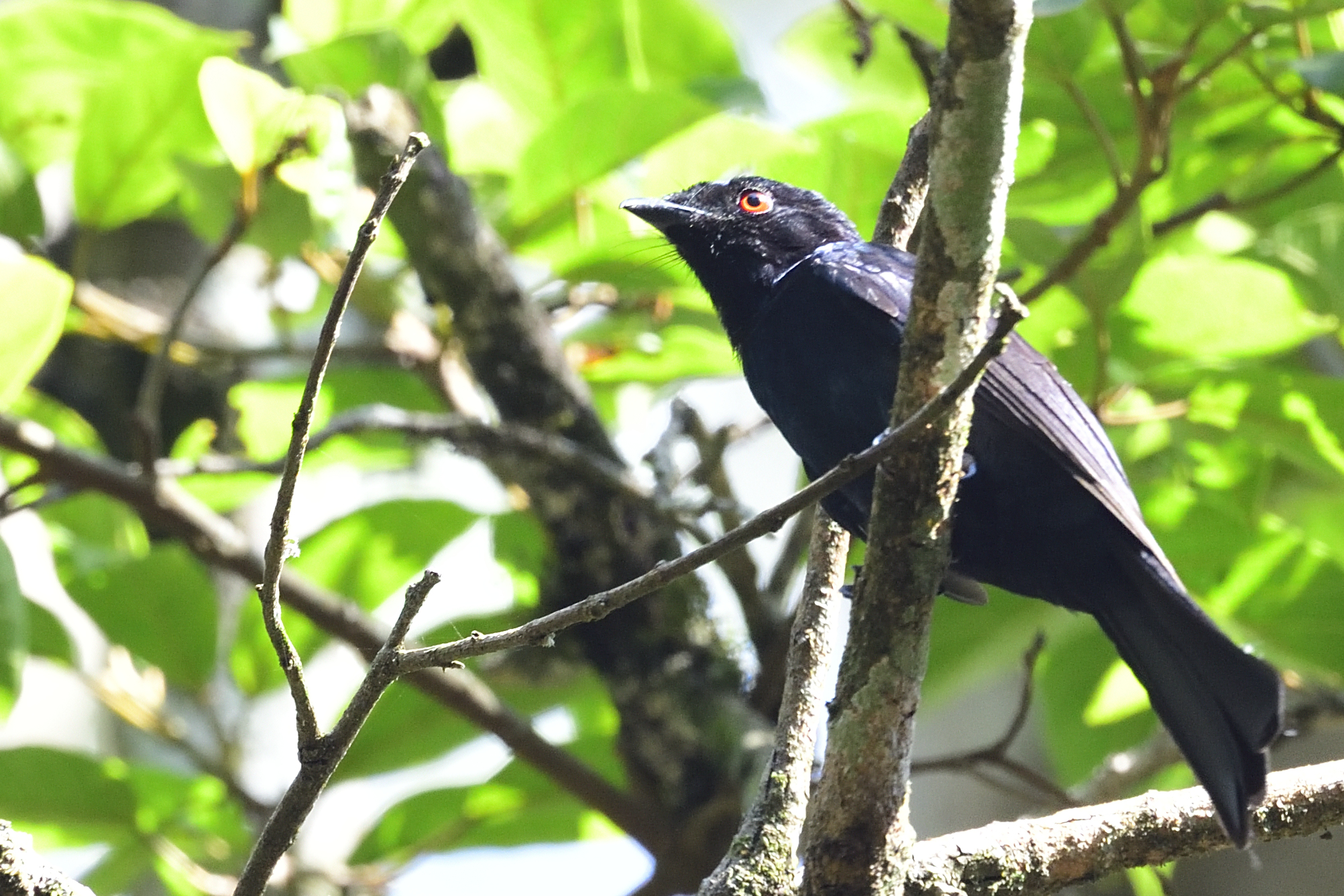
Sharpe´s Drongo, Dicrurus sharpei

White-headed Wood Hoopoe, Pheniculus bollei

White-breasted Nigrita, Nigrita fusconutus

Ugandan Woodland Warbler, Phylloscopus budongoensis

Slender-billed Greenbul, Stelgidillas gracilirostris

Crowned Eagle (juvenile), Stephanoaetus coronatus

Vieillot´s Black Weaver, Ploceus nigerrimus

Stout Cisticola, Cisticola robustus

Purple Roller, Coracias naevius

Blue-headed Bee-eater, Merops muelleri
Day 14, Saturday, February 19 – Kakamega Forest
In the morning we went back to the path with the stream and walked up again: Mountain Wagtail, Great Blue Turaco, Yellow-crested Woodpecker and Lesser Honeyguide were new birds for Kakamega Forest. We drove back towards camp and took a path just before Rondo Retreat: Jameson´s and Yellow-bellied Wattle-eye, Brown-chested Alethe, Blue-shouldered Robin-Chat and Western Oriole were added. We returned to camp for breakfast. After breakfast, we went back to the Rondo retreat. We managed to find Olive-green Camaroptera and another Brown-chested Alethe. After lunch, we only added African Dusky Flycatcher to our Kakamega list.
Here are some pictures from Day 14:

Yellow-crested Woodpecker, Chloropicus xantolophus

Yellow-bellied Wattle-eye, Platysteira concreta

Brown-chested Alethe, Pseudalethe poliocephala
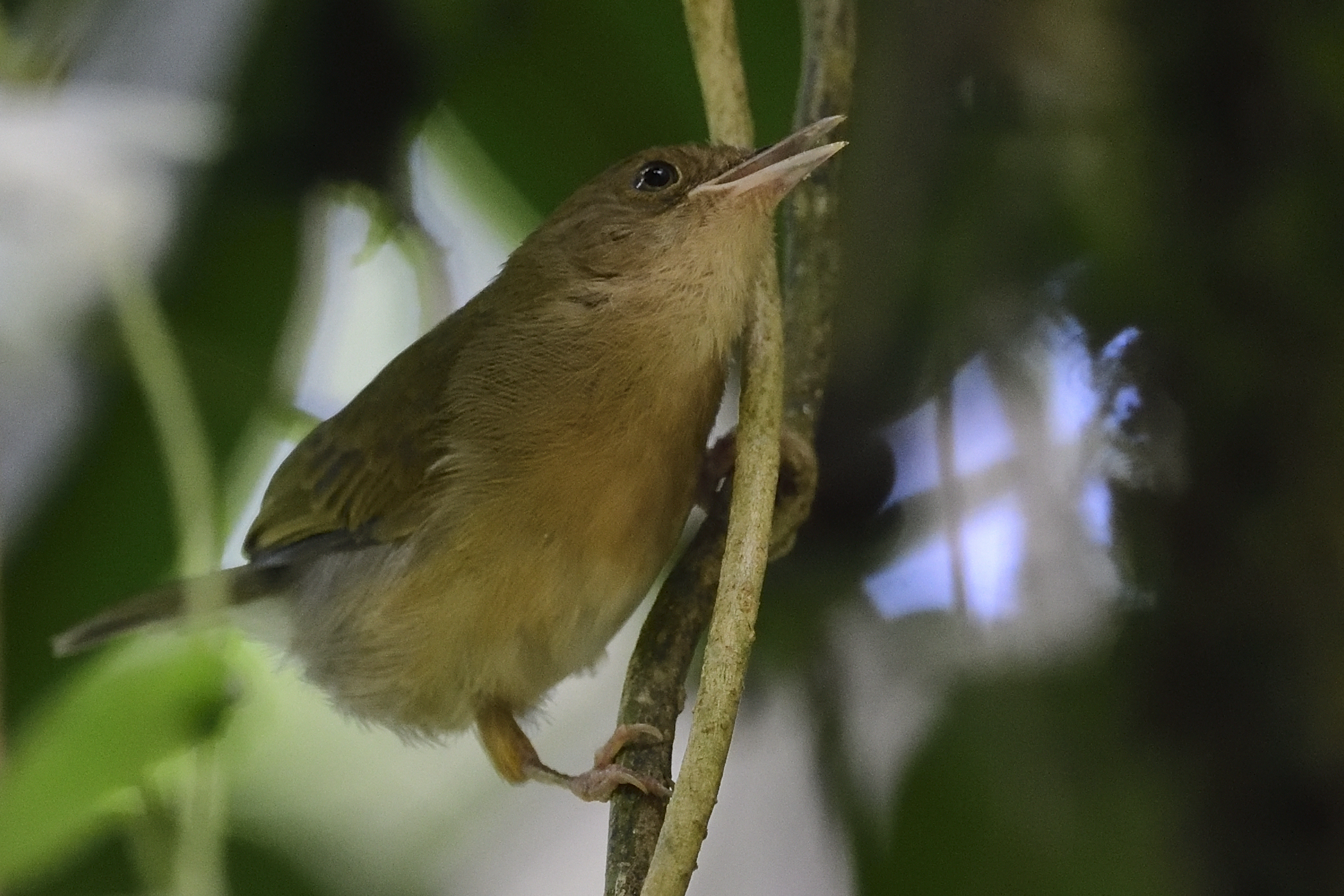
Olive-green camaraoptera, Camaroptera chloronata

African Paradise Flycatcher (white morph), Tersiphone viridis

Mackinnon´s Shrike, Lanius mackinnoni
Day 15, Sunday, February 20 – Kakamega Forest to Kisumu
We still had a morning birding session that morning in Kakamega Forest before we had breakfast and headed off for Kisumu. Some of the birds we picked up on the morning birding: White-browed Robin-Chat, Dark-backed Weaver, Brown Illadopsis, Equatorial Akalat, Blue-shouldered Robin-Vhat (Picture Lifer for me) and finally one of Trygve´s Target Birds: Ross´s Turaco. We had breakfast and drove straight to Kisumo. Our first stop there was at the Hippo Point. Our boat guide for the day after was already there to wait for us. Unfortunately it was a Sunday and a lot of people there. That still did not hinder us to get some of the Lake Victoria specials: Greater Swamp Warbler, Northern Brown-throated, Slender-billed and Village Weavers, Sedge Warbler (EA Lifer for me), Yellow-fronted Tinkerbird, Red-chested Sunbird, Angolan Swallow, Black-headed Gonolek, Swamp Flycatcher, African Marsh Harrier, Broad-billed Roller, Winding Cisticola. Selvine had found us a hotel so we went there for lunch. After lunch we went back to Hippo Point and found: Woodland Kingfisher, Fischer´s Lovebird (probably an escapee), Alpine Swift, Rüppel´s Starling, Grey-backed Fiscal and Water Thick-knee. We went back to the hotel. Freshened up and had dinner.
Some pictures from day 15:

Grey-throated Barbet, Gymnobucco bonapartei

White-browed Robin-Chat, Cossypha heuglini

Blue-shouldered Robi-Chat, Cossypha cyanocampter
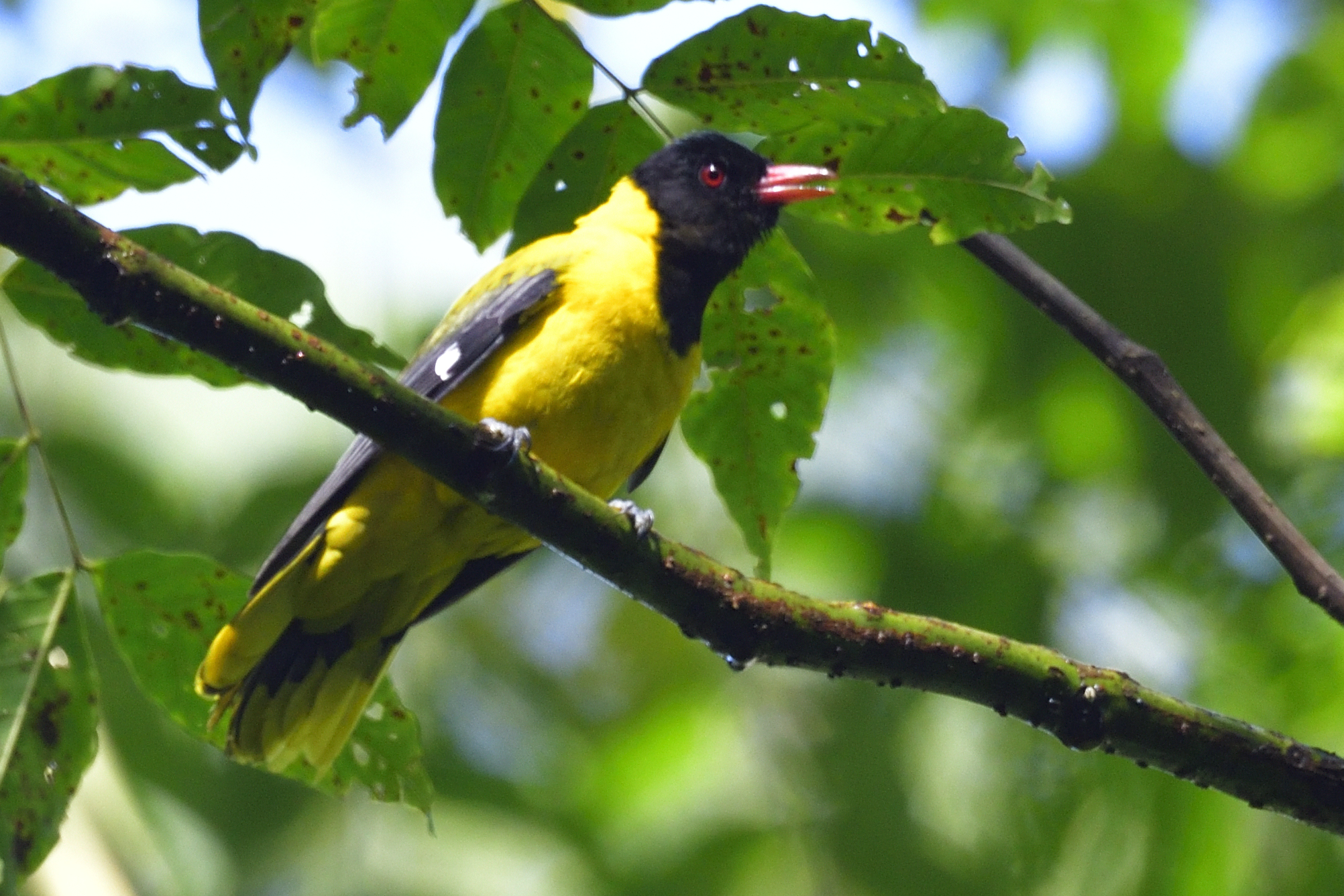
Western Oriole, Oriolus brachyrybchus

Black-billed Weaver, Ploceus melanogaster
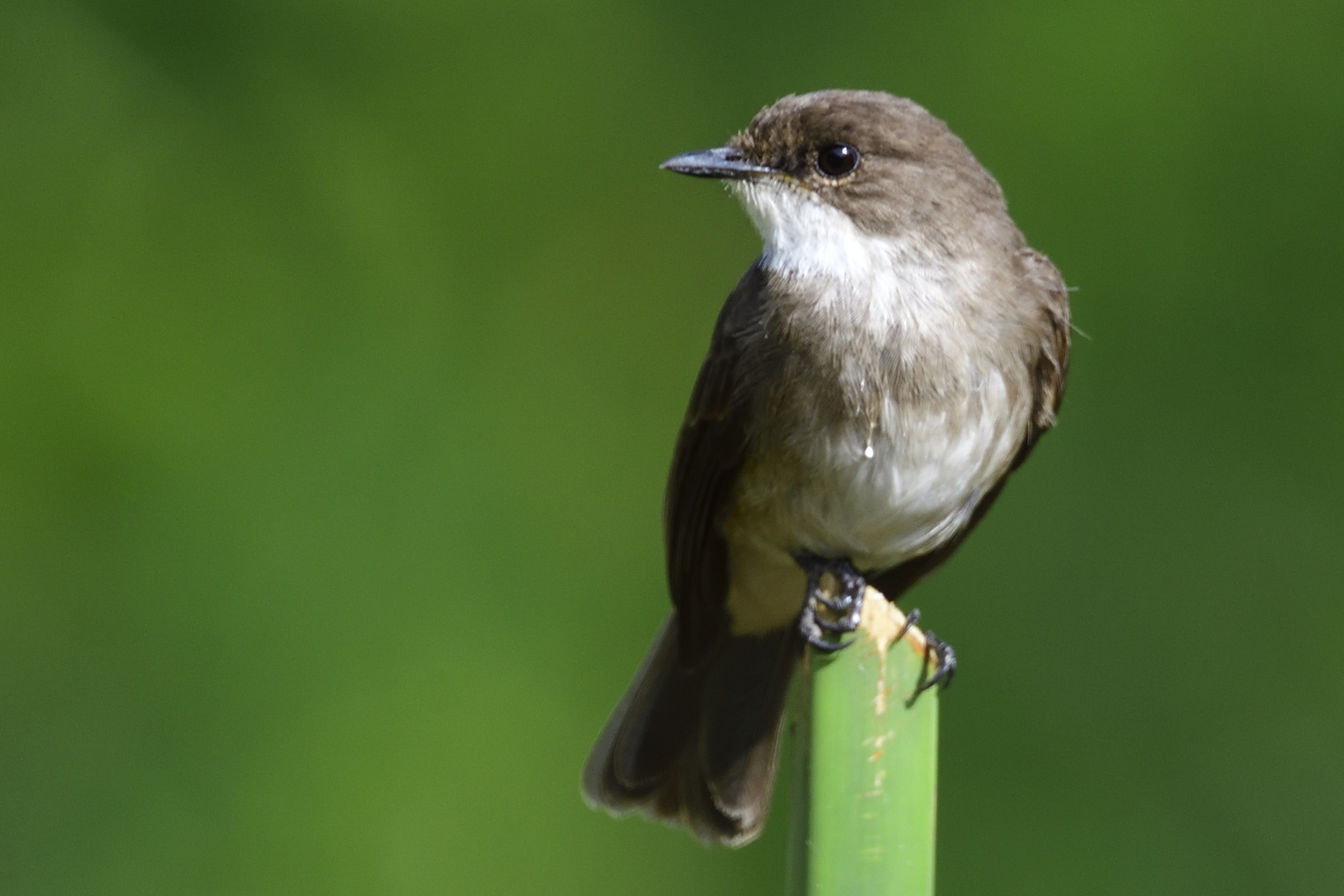
Swamp Flycatcher, Muscicapa ayatica
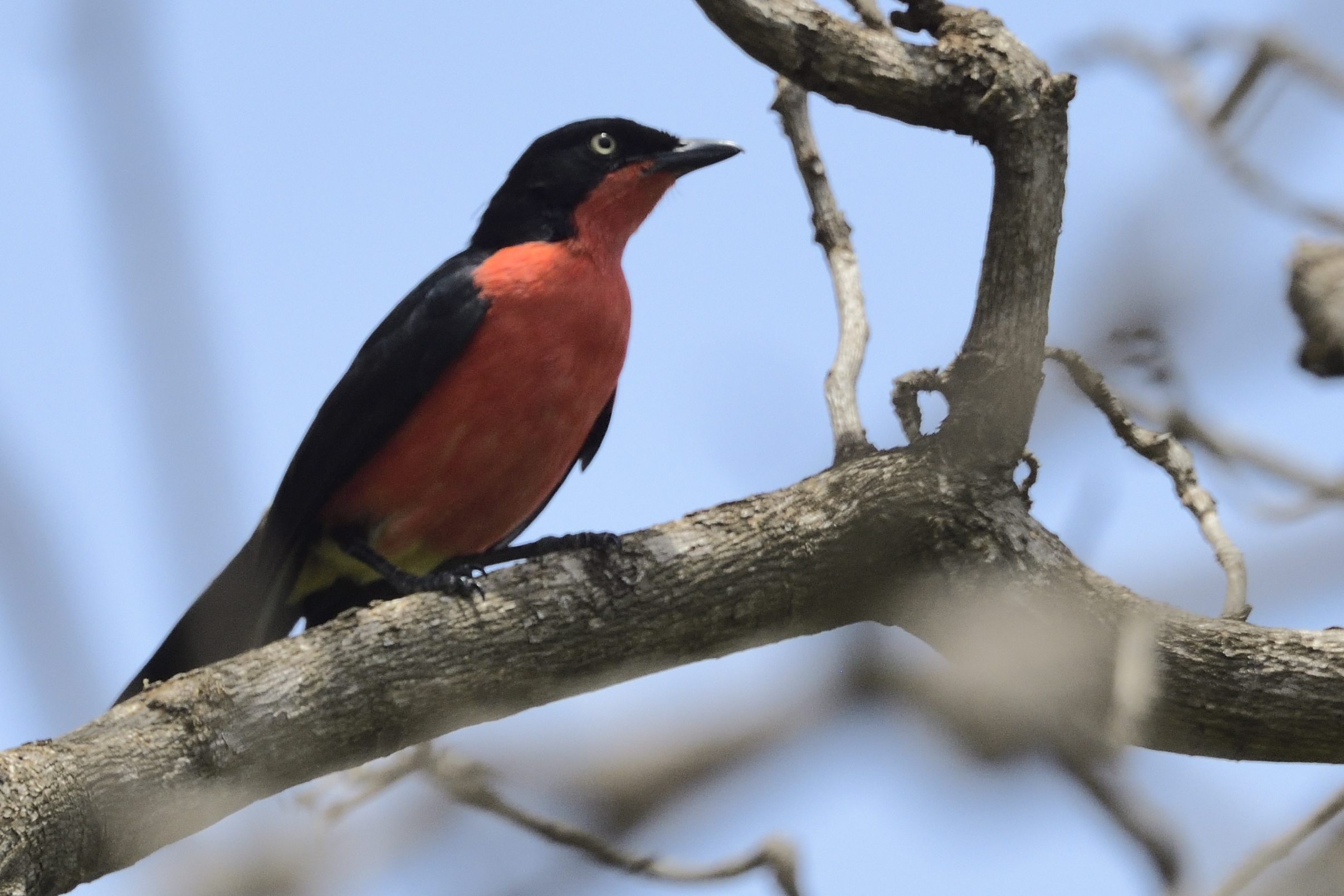
Black-headed Gonolek, Laniarius erythrogaster

Woodland Kingfisher, Halcyon senegalensis

Fischer´s Lovebrid (Probably an escapee because way out of range), Agapornis fischeri

Red-chested Sunbird, Cinnyris erythrocercus – Endemic to NE Africa

Whiskered-Tern, Clidonias hybrida

Yellow-fronted Tinkerbird, Pogoniulus chrysoconus

Slender-billed Weaver, Ploceus pelzelni

Village Weaver, Ploceus cucullatus – race bohndorffi
Day 16, Monday, February 21 – Kisumu to Kipipiri Camp at the foothills of Aberdere Montains.
That morning, we had a boat ride on Lake Victoria. We met the guide at 7, but did not have a really good morning. Some of the birds we registered: Eastern Plantain-eater, Papyrus Canaray, Little Bittern, Highland Rush Warbler, Malachite Kingfisher, Papyrus Gonolek, Carruther´s Cisticola, Village Weaver and Blue-headed Coucal. We had a 6 hour long drive ahead of us, so we finished the boat trip by 10, had breakfast at the hotel, packed the car and was on our way. We had no problems on the road. Just before Kipipiri camp we scanned for Jackson´s Widowbird, but could only find Long-tailed Widowbirds. We were at Kipipiri camp around 4. My friend Alnavaz, the owner of the camp, had a late lunch ready for us. The only problem was that it were raining cats and dogs when we arrived. Our original plan were to drive up to Aberdere National Park that afternoon, but that plan was cancelled due to the rain. We were however rewarded by a fly over of two Olive Ibises around 18:00. We just relaxed until dinner and then retired early.
Some pictures from day 16

Little Bittern, Ixobryvhus minutus
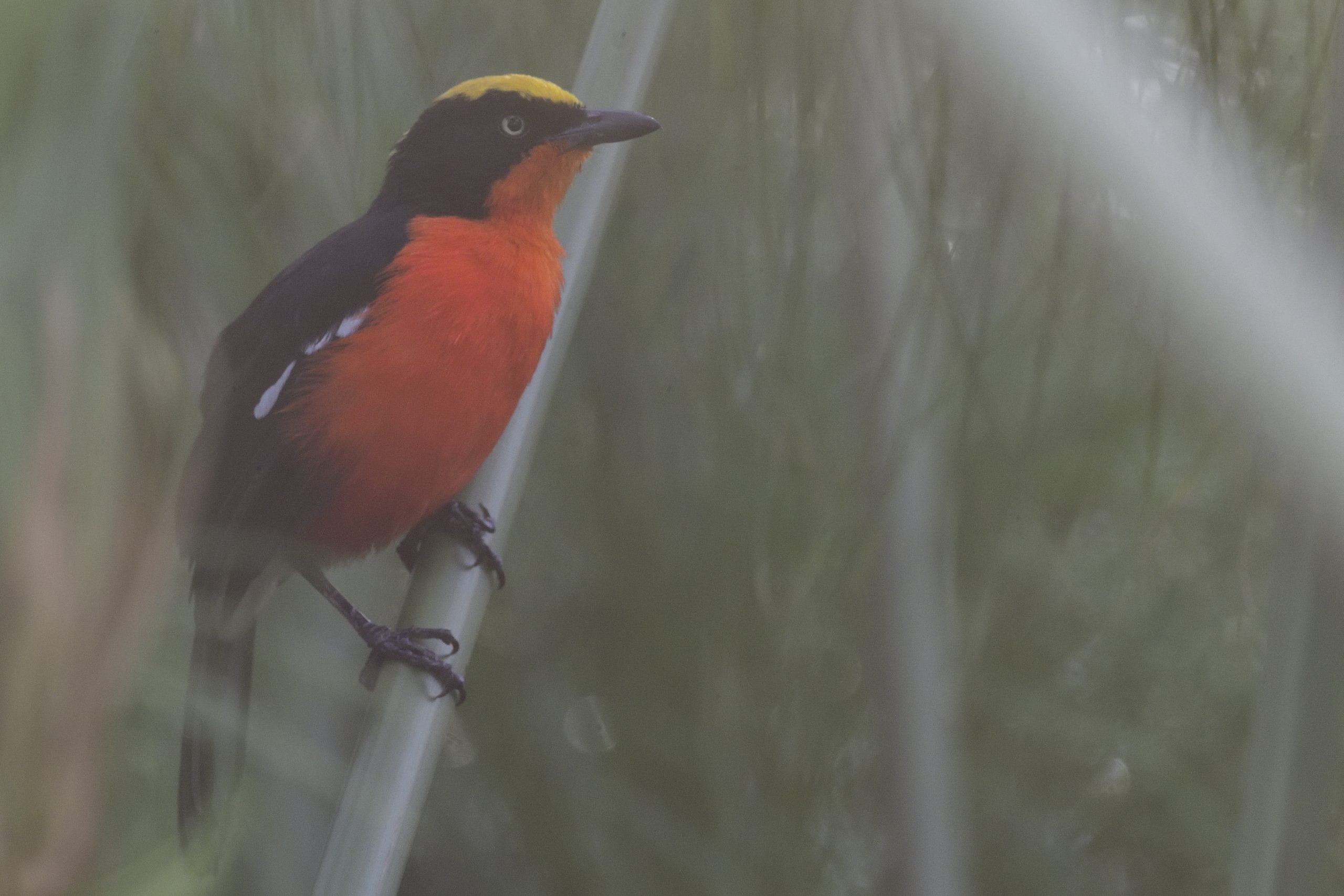
Papyrus Gonolek, Laniarius mufumbiri – Endemic to East Africa
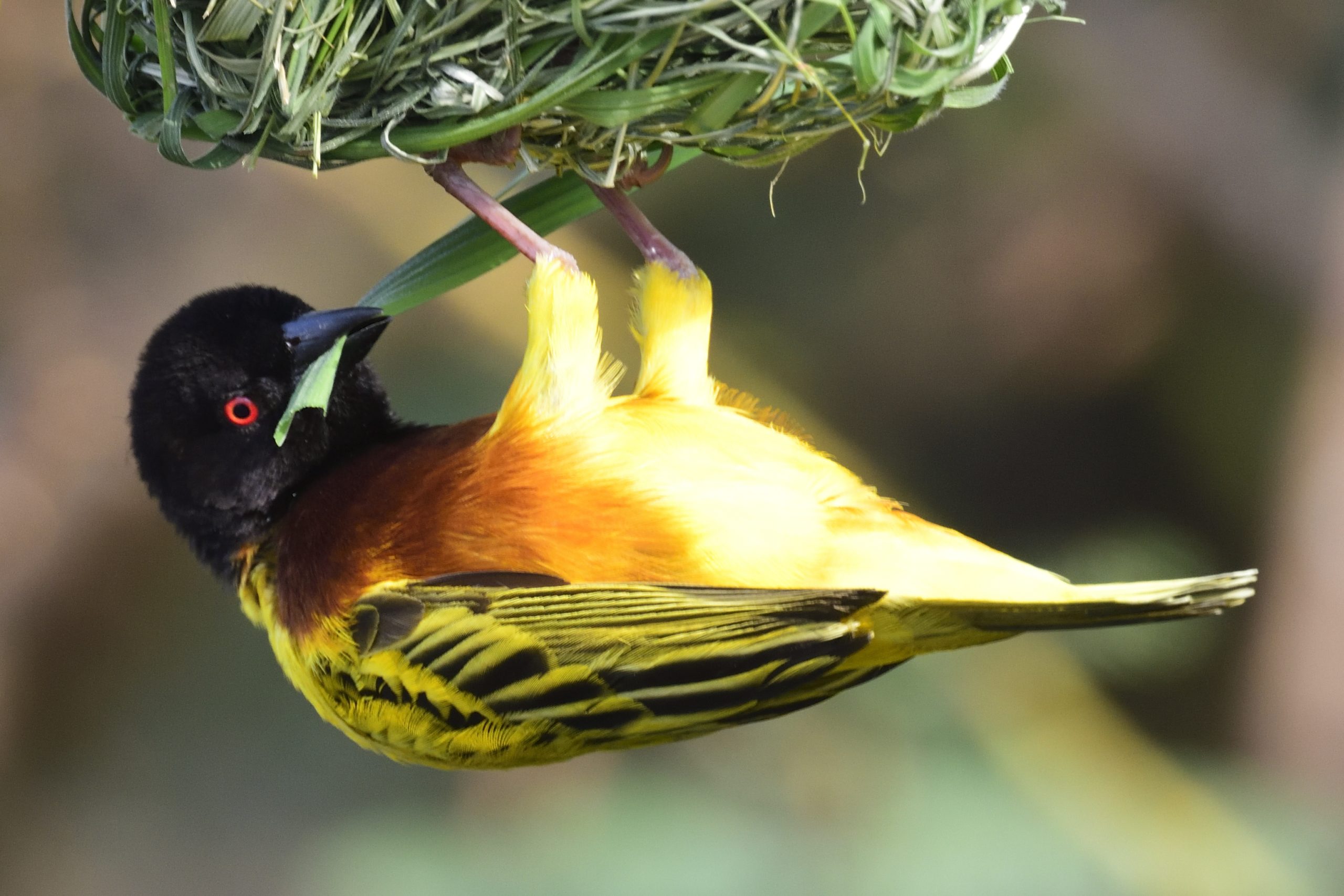
Golden-backed Weaver, Ploceus jacksoni – Endemic to East Africa

Long-tailed Widowbird, Euplectes progne
Day 17, Tuesday, February 22 – Kipipiri Camp – Aberdere NP, Kinangop Patau – Nairobi
We started driving up towards Aberdere National Park that morning once we had light. On the way up to the gate, we picked up: White-starred Robin, Golden-winged Sunbird, Jackson´s Francolin and at the gate Moorland Chat. I told the ranger that we would spend maximum 30 minutes inside the park, but we still had to pay full price. The only target in the park is the endemic Aberdere Cisticola. As before, we found it quite easily. We were out of the park after about 20 minutes. We drove down to Kipiri camp, had breakfast and packed the car. We had met our guide John Gitiri the night before. He had a special place for another Kenyan endemic, Sharpes Lonclaw. He found the bird easy and we picked up these additional species: Levaillant´s and Wing-snapping Cisticola and Quailfinch. We normally stop at another place for Stout Cisticola, but since we had it from Kakamega there were no reason to stop. We drove back to Nairobi and checked in to the Hotel Troy again and thus the trip were finished for this time:
Some pictures from Day 17:

Jackson´s Francolin, Pternistis jacksoni – Endemic to Kenya

Aberdere Cisticola, Cisticola aberdere – Endemic to Kenya
It was a succesfull trip in the case that we found all the Kenyan Endemics we coud find. The bird count was a little low with just over 400 species on the main trip and about 450 with the 3 days in advance. Even though all my 3 friends had never met, they were all bird photographers and as such we had a slow phased approach to the birding. . I got 3 lifers on the trip (Mbulu White-eye, Shining Sunbird and Brown-backed Woodpecker), some EA lifers and EA Photo lifers. I have now photographed 1014 species in East Africa and have seen 1084. Still a lot of work to do. I have a new Usambara Tanzania trip on April 14. Stay tuned for more trip reports and also more pictures loaded under my bird photo section on my web page holmen-birding-safari.com. Below you will find a map of the route driven on our trip.

Map of the places we visited in Kenya